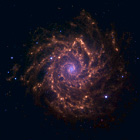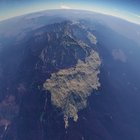|
Tour of the Kocab system
|
|
| curiousepic | Date: Monday, 12.12.2011, 04:34 | Message # 1 |
 Space Pilot
Group: SE team
 United States
United States
Messages: 141
Status: Offline
| Picking a star at random and heading off into the deepness, I ended up at Kocab, aka Kochab or Beta Ursae Minoris. By coincidence, this star used to be Earth's North pole star. It has great diversity, so I decided to document my exploration.
Note these images are about 1920 wide, so I spoiled them for those who might have trouble.
Kocab 1, a cold ice giant, has one of the coolest storm spots I've ever seen:
Its second moon is a hot ocean world with dense, yellowish cloud cover:
I caught one of its other moons just as it was transiting across its face - you can just barely make out the shadow near the center-bottom:
A nice sunset on Kocab's 5th moon, a cold desert world, with Kocab and a few other moons in the sky:
The crown discovery of this system - a terrestrial world orbitting Kocab's second giant planet. It features a huge, but relatively shallow crater sea:
Another view, lit from both the star and Kocab 2. This shot also reveals that Kocab has a red dwarf companion:
Some nice terrain near the crater sea:
A chain of islands terminating in what has to be the tiniest island in the universe!
And here we have a timelapse of Kocab 2 bobbing up and down on the horizon of Kocab 2.2. This planet must be tidally locked for it to stay in view:
On the outskirts of Kocab 2, I found a really interesting hunchback-shaped asteroid:
A frozen ocean world with some really varied terrain, orbiting Kocab 3:
Interesting string of linked craters on Kocab 3.7:
Kocab 4, a very handsome gas giant with what seems like very little wind in its lower latitudes:
I noticed some odd cloud formations on Kocab 4's first desert moon:
Absolutely gorgeous shot of Kocab illuminating storm clouds on a frozen moon of Kocab 4:
Another shot of Kocab 4.3:
Video of that view. This and other moons of Kocab 4 have a steep inclination, similar to Uranus, which causes them to rotate perpendicular to their star at least some of the time:
Very pleasant atmosphere on this icy world:
My ideal preferences for visual design of the mothership and technology in SE
Harry Potter and the Methods of Rationality
Edited by curiousepic - Monday, 12.12.2011, 19:50 |
| |
| |
| mustafa2812 | Date: Monday, 12.12.2011, 06:41 | Message # 2 |
 Space Pilot
Group: Users
 United States
United States
Messages: 121
Status: Offline
| Wow. I am going to start making journals like this of my space travels. Very well done sir or madame!
PC specs: Windows 7 64 bit. Intel Core i5-2400 quad-core (3.1GHz, 6MB Cache). 6GB DDR3-1333MGz SDRAM[2 DIMMs]. 1 TB 7200 rpm SATA 3Gb/s hard drive. 3GB DDR3 NVIDIA GeForce GT 545.
|
| |
| |
| curiousepic | Date: Monday, 12.12.2011, 17:32 | Message # 3 |
 Space Pilot
Group: SE team
 United States
United States
Messages: 141
Status: Offline
| Thanks.
Actually - SpaceEngineer or any other astrophysicists out there... Kocab 2.2 seems tidally locked, but it's very far from its host planet, it's also wobbling a bit. Is there another explanation for the behavior in the first video? Or can moons that far out be locked?
EDIT: Just realized Youtube blocks the video I'm talking about because of my choice of music. I've changed the music, so hopefully you'll be able to watch it soon.
My ideal preferences for visual design of the mothership and technology in SE
Harry Potter and the Methods of Rationality
Edited by curiousepic - Monday, 12.12.2011, 20:02 |
| |
| |
| HarbingerDawn | Date: Monday, 12.12.2011, 22:52 | Message # 4 |
 Cosmic Curator
Group: Administrators
 United States
United States
Messages: 8717
Status: Offline
| Quote (curiousepic) Kocab 2.2 seems tidally locked, but it's very far from its host planet, it's also wobbling a bit. Is there another explanation for the behavior in the first video? Or can moons that far out be locked?
It is tidally locked. It's not that far away from its planet; both Titan and Callisto are farther from Saturn and Jupiter and they're locked.
As for the wobbling, that's caused by orbital eccentricity. Since the orbit is not a perfect circle, the moon will move faster at some points in its orbit (when closer to the planet) and slower at others (when farther from the planet). The rotation rate, however, remains constant. So to an observer on the moon, the planet would seem to move up and down in the sky as the moon went about its orbit. Go to Earth's moon and look at Earth for a few orbits: you'll notice the same effect.
All forum users, please read this!
My SE mods and addons
Phenom II X6 1090T 3.2 GHz, 16 GB DDR3 RAM, GTX 970 3584 MB VRAM
|
| |
| |
| SpaceEngineer | Date: Tuesday, 13.12.2011, 01:22 | Message # 5 |
 Author of Space Engine
Group: Administrators
 Russian Federation
Russian Federation
Messages: 4800
Status: Offline
| Quote (HarbingerDawn) Go to Earth's moon and look at Earth for a few orbits: you'll notice the same effect.
This is also called a Moon's librations.
*

|
| |
| |